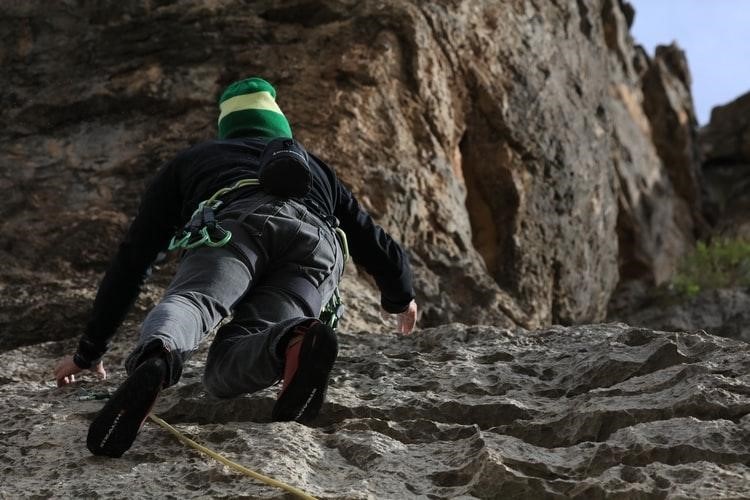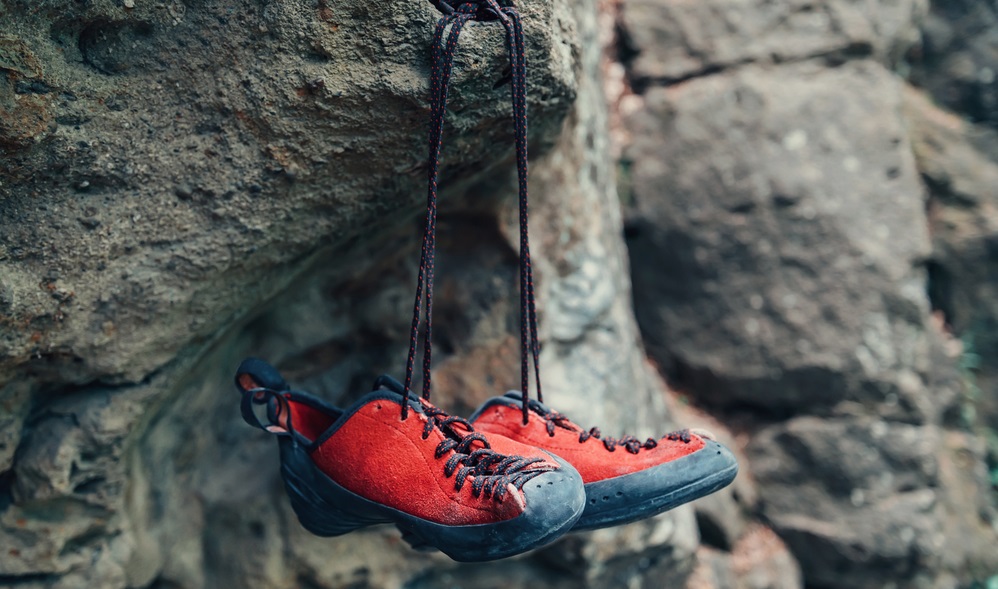Last Updated on October 25, 2022 by admin
If you are suffering when wearing your climbing shoes, you probably have bought a size too small, or the instep part is too tight. It is always advisable to buy climbing shoes one or even two sizes smaller to get a better grip on the rocks. That’s why you may need to use a shoe stretcher to stretch your shoes and make them a little more comfortable to avoid foot pain.
There are different techniques you can use to make your climbing shoes bigger. Whether you need to stretch just the synthetic upper or the entire shoe, let’s look at how to break in climbing shoes. With these tips, you will be able to avoid the pain those tight climbing shoes cause you.
Materials
- A balloon
- Water
- A glass beaker
Your Freezer
Freezing your rock-climbing shoes overnight is a good way to avoid pain and blisters. Below you will find the steps on how to do this. This method can be used on your leather climbing shoes or synthetic climbing shoes.
Procedure
- Fill the balloon with water. The amount of water should be calculated depending on how much you need to enlarge the instep of your climbing shoe. Then, tie a knot in the balloon so that the water does not leak out.
- Put the balloon in the freezer for about 1 hour or until the water is semi-frozen.
- Once the water in the balloon has some ice in it, take it out of the freezer and insert it into the climbing shoe you want to mold.
- The glass cup pushes the balloon with a little pressure until it fills all the spaces in the upper of the shoe. Be very careful not to burst the balloon.
- Once the balloon has taken the shoe’s shape in the area you want to stretch, you must close the shoe. Use Velcro or laces as appropriate. The important thing is that it is tight enough so that you get the desired result.
- Finally, put your climbing shoe in the freezer so that the water in the balloon finishes freezing and the glass exerts more pressure on the instep.
- Let your climbing shoe stay in the freezer for 3-4 days to get the instep to stretch. Then, be sure to check every day to see how the procedure is working.
Break-In Your Climbing Shoes with Heat
As we mentioned initially, there are different ways to stretch your climbing shoes and prevent them from hurting your feet. The most effective is by using your home freezer. However, if you need an immediate result, you can use another technique. This time using heat. We explain how you can apply it:
Using a Hairdryer
- Insert several clean socks rolled up inside the climbing shoe. Fill the shoes’ toe by exerting pressure, and then insert more socks until the shoe is full. Insert as many socks as possible so that there is more pressure inside the socks and the shoe can stretch successfully.
- With your hairdryer on medium heat, heat the shoes. Try to keep approximately 15 cm between the hairdryer and the shoe. Run the hairdryer all over the shoe so that the heat reaches the shoe evenly. Do this for 1 minute. Then, carefully touch the shoe to check the temperature. If necessary, try for another 30 seconds to 1 minute.
- By this time, the material of your shoe should have expanded a bit. Add more socks and compact to exert even more pressure.
- Leave the thick socks inside the climbing shoes until they are completely cool. Afterward, take the thick socks out and try on the shoes. You should feel a little more room between your toes and that you can move them more comfortably.
Heat is especially helpful for leather climbing shoes because it makes the shoe material more pliable so the thick socks can stretch the shoes out.
Using Hot Water
- Put on your climbing shoes and tie the laces, making sure they are snug but not too tight
- Once your shoes are on, take a hot water bath. Make sure the water is warm and the shoes are completely wet. The water and your foot will help expand the material of your climbing shoes
- Walk around in the wet shoes until they begin to dry
- Put newspaper in the wet shoe to help keep your foot shape
- Try climbing with slightly damp shoes. However, they should not be completely wet as this can make climbing very uncomfortable
Types of Climbing Shoes

Neutral Shoe
If you are a beginner in the art of climbing, a neutral shoe is the most suitable for you. Or, if you already have experience, these shoes will help you do a long route. The soles of these shoes are thicker and provide stability and support. In addition, the fit is adequate and can relax your feet, which allows you to have a good grip on cracks and you can use them for much longer.
Moderate Shoe
The sole of a moderate shoe is thinner than neutral climbing shoes allowing for more versatility when climbing. It will enable you to climb in cracks and overhangs. They have a lower design. Not recommended as a beginner shoe as they are tighter and can be uncomfortable for people just starting to climb.
Aggressive Shoe
The main characteristic of the aggressive shoe type climbing shoe is that they are very tight shoes. The sole is much thinner than neutral climbing shoes. The design of an aggressive climbing shoe is asymmetrical, and they have a curvature in the direction of the thumb. This helps to have more precision and grip on small holds. In addition, they are very snug in the heel for better performance on more challenging climbing.
Conclusion
It is important to emphasize that the type of rock-climbing shoe size varies a lot from one model to another despite belonging to the same brand. Be very careful when choosing sport climbing shoes. When sizing a climbing shoe, make sure that your foot does not slip into the bottom of the shoe easily. It should be snug but not so tight that it hurts your feet.
It’s much better to make a proper purchase rather than trying to stretch your sport climbing shoes. Foot pain is something that can be prevented right from the purchase. If you buy the wrong size shoes and try to break them in, it is possible that if you want to return them, the store will no longer accept them as a return.

